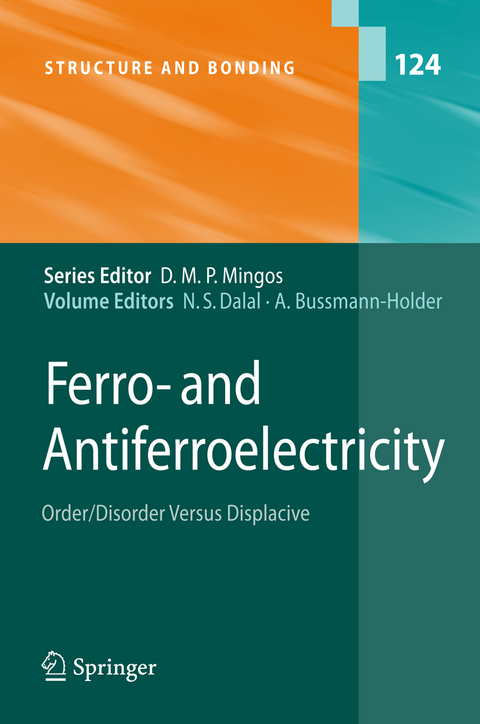
Ferro- and Antiferroelectricity
Order/Disorder versus Displacive
Seiten
2007
|
2007
Springer Berlin (Verlag)
978-3-540-49602-1 (ISBN)
Springer Berlin (Verlag)
978-3-540-49602-1 (ISBN)
With contributions by numerous experts
Solid-state systems are frequently classi?ed according to their physical, str- tural or chemical properties. Such schemes are extremely helpful since pr- erties related to any such classi?cation are typically known and facilitate id- tifying solids with special material classes. The best-known examples of these schemes are conductivity or resistivity measurements by means of which m- als are easily distinguishable from insulators. However, frequently clear-cut decisions between material classes are not possible, since anisotropy, chemical composition, binding forces and local effects wash out distinct properties and lead to competition or coexistence. Such unresolved situations are especially typical for transition metal oxides that exhibit a variety of ground-state properties in a fascinating way. Here chemical substitution, doping, pressure or temperature effects easily in?uence the physical properties and may, for instance, induce metal/insulator, antif- romagnet/ferromagnet, insulator/superconductor transitions. This situation is analogous to perovskite ferroelectrics and hydrogen-bonded ferroelectrics, where ferroelectric/antiferroelectric transitions occur with chemical substi- tions of one of the constituent sublattices. In addition, glass-like states (dipolar glasses) are observed and relaxor ferroelectricity with a large potential for - plication frequently occurs.
Solid-state systems are frequently classi?ed according to their physical, str- tural or chemical properties. Such schemes are extremely helpful since pr- erties related to any such classi?cation are typically known and facilitate id- tifying solids with special material classes. The best-known examples of these schemes are conductivity or resistivity measurements by means of which m- als are easily distinguishable from insulators. However, frequently clear-cut decisions between material classes are not possible, since anisotropy, chemical composition, binding forces and local effects wash out distinct properties and lead to competition or coexistence. Such unresolved situations are especially typical for transition metal oxides that exhibit a variety of ground-state properties in a fascinating way. Here chemical substitution, doping, pressure or temperature effects easily in?uence the physical properties and may, for instance, induce metal/insulator, antif- romagnet/ferromagnet, insulator/superconductor transitions. This situation is analogous to perovskite ferroelectrics and hydrogen-bonded ferroelectrics, where ferroelectric/antiferroelectric transitions occur with chemical substi- tions of one of the constituent sublattices. In addition, glass-like states (dipolar glasses) are observed and relaxor ferroelectricity with a large potential for - plication frequently occurs.
Order/Disorder Versus or with Displacive Dynamics in Ferroelectric Systems.- Experimental Evidence for the Coexistence of Order/Disorder and Displacive Behavior of Hydrogen-Bonded Ferroelectrics and Antiferroelectrics.- Order and Disorder in Perovskites and Relaxor Ferroelectrics.- Local Structure and Dynamics of Ferroelectric Solids.- Ferroelectricity of SrTiO3 Induced by Oxygen Isotope Exchange.- Evidence for Ferroelectric Nucleation Centres in the Pseudo-spin Glass System Rb1?x (ND4) x D2PO4: A 87Rb NMR Study.- Anharmonic and Quantum Effects in KDP-Type Ferroelectrics: Modified Strong Dipole-Proton Coupling Model.- A Comparison of Magnetic Random Access Memories (MRAMs) and Ferroelectric Random Access Memories (FRAMs).
| Erscheint lt. Verlag | 16.3.2007 |
|---|---|
| Reihe/Serie | Structure and Bonding |
| Zusatzinfo | XIV, 220 p. |
| Verlagsort | Berlin |
| Sprache | englisch |
| Maße | 155 x 235 mm |
| Gewicht | 10 g |
| Themenwelt | Naturwissenschaften ► Chemie ► Anorganische Chemie |
| Naturwissenschaften ► Chemie ► Physikalische Chemie | |
| Technik ► Elektrotechnik / Energietechnik | |
| Technik ► Maschinenbau | |
| Schlagworte | Electrochemistry • electromaterials • ferroelectricity • Ferroelectrics • Ion • lead • metals • oxygen • Transition metal |
| ISBN-10 | 3-540-49602-5 / 3540496025 |
| ISBN-13 | 978-3-540-49602-1 / 9783540496021 |
| Zustand | Neuware |
| Haben Sie eine Frage zum Produkt? |
Mehr entdecken
aus dem Bereich
aus dem Bereich
Buch | Hardcover (2024)
Springer Spektrum (Verlag)
CHF 89,95


